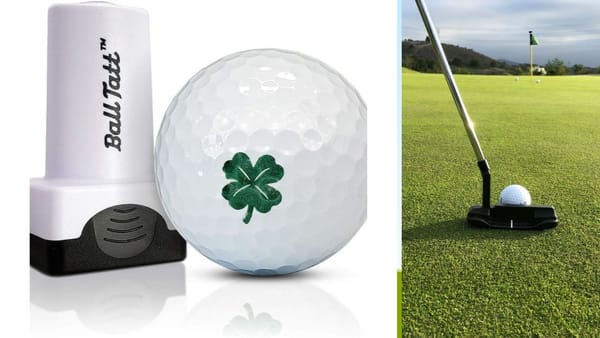Greetings, fellow golf enthusiasts! In this article, we'll shed light on a skill that can significantly enhance your game: putting a backspin on a golf ball.
Picture this: you're on the fairway, with a daunting bunker and a fast green standing between you and the pin.
Or perhaps you're faced with a tight flag position tucked just behind a bunker. In these situations, the ability to spin the ball becomes not just a luxury but a necessity.
Whether you're a seasoned player or an average golfer, mastering the art of backspin can be a game-changer.
It's the secret weapon that can help you hold those treacherous greens, avoid hazards, and get closer to the hole with precision and control.
In this guide, I'll take you through the essential techniques and strategies for putting backspin on your golf ball, allowing you to tackle challenging situations on the course like a pro. So, let's dive in and uncover how this skill can benefit golfers of all levels.
Choosing the Right Club:
Choosing the right club to achieve backspin on a golf ball is crucial for golfers looking to control their shots and stop the ball quickly on the greens.
The primary factors to consider when selecting the appropriate club for generating backspin include club selection and swing technique.
For starters, opt for clubs with a higher loft, such as wedges and short irons, as they inherently create more backspin due to their steeper angles.
Next, focus on the condition of your clubface and the quality of your golf ball; clean grooves on the clubface and a high-quality, urethane-covered golf ball can enhance spin.
Lastly, fine-tune your swing by creating a shallow angle of attack and striking the ball cleanly, with a slightly descending blow. Moreover, incorporating a wrist hinge during your backswing and releasing it at impact can also add a backspin.
Ultimately, choosing the right club for backspin necessitates a combination of proper equipment, technique, and practice to achieve those desired results on the golf course.

Clean Clubface and Golf Ball:
Cleaning your clubhead and golf ball is essential to maximize ball spin in golf. When you strike the ball, any debris or dirt on the clubface can impede the interaction between the club and the ball, reducing the ability to create a backspin.
A clean clubface ensures that the grooves on the club can grip the ball effectively, creating more friction and generating the necessary spin to control your shots.
Likewise, a clean golf ball minimizes any foreign substances that could interfere with the interaction between the club and the ball, enabling the ball to react as intended upon impact.
Maintaining a clean clubhead and golf ball is a simple yet crucial step to achieving the desired spin and control in your golf shots, ultimately improving your overall performance on the course.
Refined Grip and Stance:
Having a refined grip and proper stance in golf is crucial for achieving proper ball spin. The grip is the golfer's connection to the club, and any deviations in its placement can greatly affect the clubface's orientation at impact.
A consistent grip ensures that the clubface is square to the target, enabling the golfer to generate the desired spin on the ball.
Likewise, a proper stance establishes a solid foundation, promoting balance and weight transfer during the swing.
balance is essential for maintaining control over the clubhead, allowing for clean contact with the ball.
Without these fundamental elements in place, achieving the right spin becomes a daunting task, as the clubface can open or close unpredictably, leading to erratic shots and diminished control over the ball's trajectory.
In essence, a refined grip and proper stance are the building blocks for a golfer's ability to impart the necessary spin on the ball, ultimately leading to improved accuracy and performance on the course.

Strategic Ball Placement:
Strategic ball placement is crucial in golf for obtaining ball spin because it directly impacts the golfer's ability to control the trajectory and movement of the ball.
By carefully positioning the ball about the clubface, golfers can influence the angle of attack and the contact point with the ball.
This, in turn, affects the amount and type of spin generated. Backspin, for instance, can help the ball stop quickly on the green, while sidespin can make the ball curve in a controlled manner.
Without precise ball placement, achieving the desired spin becomes inconsistent and challenging.
Thus, mastering the art of strategic ball placement is fundamental for golfers seeking greater control, accuracy, and finesse in their shots, ultimately enhancing their overall performance on the course.
Controlled Swing Speed:
Swing speed plays a pivotal role in optimizing ball spin in golf, as it directly influences the level of control, distance, and trajectory a golfer can achieve with their shots.
A golfer's ability to generate an ideal spin rate on the golf ball hinges on the speed at which they swing the club.
When the swing speed is too slow, the ball tends to produce excessive backspin, leading to shorter distances and reduced accuracy. Conversely, an excessively high swing speed can result in insufficient spin, causing the ball to fly too low and roll excessively upon landing.
Striking the right balance in swing speed enables golfers to impart the correct amount of backspin, helping the ball hold its line in the air, stop more quickly upon landing, and find its way closer to the target.
In essence, mastering swing speed is an essential aspect of achieving precision and consistency in golf.

Proper Angle of Attack:
The angle of attack in golf is a critical factor that plays a pivotal role in optimizing ball spin and, consequently, overall shot performance. When a golfer strikes the ball, the angle at which the clubhead approaches the ball significantly influences the spin imparted to it.
A shallow angle of attack, where the clubhead skims the turf, tends to produce lower backspin and encourages a more rolling trajectory, ideal for longer shots.
Conversely, a steeper angle of attack, where the clubhead descends more sharply into the ball, generates higher backspin, allowing for better control, accuracy, and stopping power on approach shots.
Mastering the balance between these angles of attack is essential for golfers seeking to enhance their game, as it directly affects shot distance, accuracy, and the ability to hold the green with precision.
In essence, understanding and manipulating the angle of attack is a fundamental skill in golf, enabling players to optimize ball spin and ultimately elevate their performance on the course.

Practice Short Game Shots:
Practicing short-game shots in golf is of paramount importance when it comes to mastering ball spin control. While long drives may capture the spotlight, it's often the precision and finesse exhibited around the greens that make or break a golfer's performance.
The ability to impart the right amount of spin on the ball during chip shots, pitch shots, and bunker play can mean the difference between a ball stopping dead in its tracks or rolling far past the target.
A golfer who can dial in the spin can approach the game with greater confidence, knowing they have the tools to navigate tight pin positions and challenging hazards.
It's through consistent practice of these short game shots that golfers develop the touch, feel, and muscle memory needed to finesse their way to lower scores and ultimately, a more fulfilling and enjoyable golfing experience.
How To Put Backspin On A Golf Ball
Some Final Thoughts
When it comes to refining your golf skills, mastering the art of creating backspin on your golf shot can be a game changer. Not only does it add more spin to your ball, but it can also strengthen your club head speed and overall performance on the course.
To achieve this highly coveted effect, start by using hard core golf balls and utilizing the proper wedge shot technique.
Additionally, practicing a tee drill can help you perfect your stroke and gain more control over your club face. So next time you hit the links, be sure to incorporate these tips and see the difference they can make in your game.
Putting a backspin on a golf ball is an art that requires skill, technique, and practice. By following these tips and dedicating time to refine your skills, you'll be able to add that extra touch of finesse to your shots.
Remember, patience and persistence are key. So get out on the range or the course and start mastering the art of backspin!
*Note: The information provided in this article is based on general golfing principles. Individual results may vary. Always consult with a professional golf instructor for personalized coaching and guidance.
Conclusion
In the intricate game of golf, the ability to create backspin on a golf ball is a crucial skill for any player. But how do you achieve this? The secret lies in the type of golf clubs you use and the execution of the swing.
By utilizing a golf club with a sharp groove pattern and proper ball contact, players can put backspin on a golf ball, causing it to stop quickly and even roll backward on the green.
Though it takes practice and precision, mastering the art of creating backspin will undoubtedly improve your golf game and impress your fellow golfers. learning how to put backspin on a golf ball is a good skill to have on the course!












Member discussion